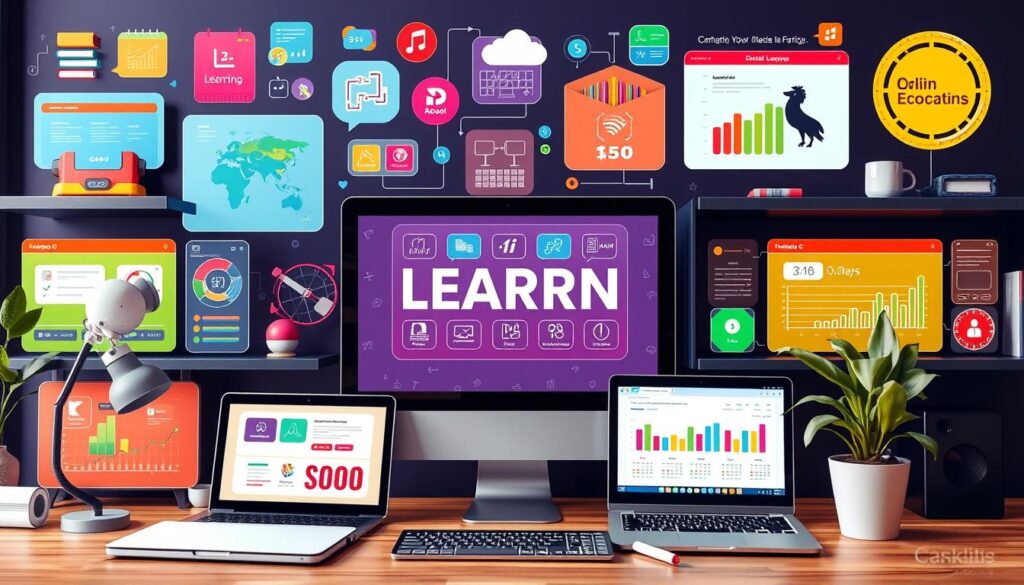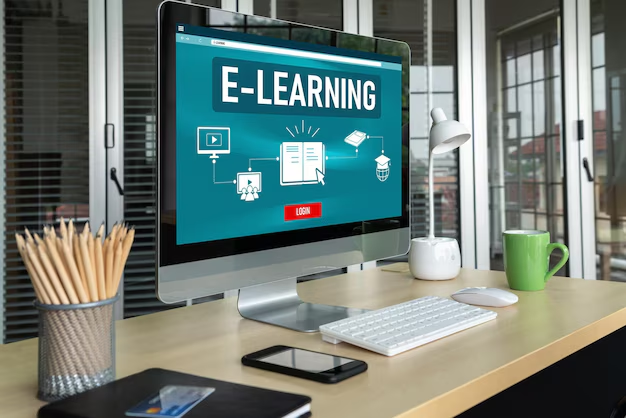E-learning platforms are changing how we learn and grow professionally. They offer flexible and personalized learning experiences. With these platforms, you can access courses and materials from anywhere with internet.
Online learning is also more affordable than traditional schools. Many platforms offer free or low-cost courses. You can even earn certificates and degrees online.
These platforms let you learn at your own pace. You can focus on what interests you most. This makes learning more flexible and enjoyable.
Key Takeaways
- E-learning platforms offer greater flexibility, lower costs, and the ability to customize content compared to traditional classroom-based education.
- These platforms provide access to courses, educational content, and learning materials from anywhere with an internet connection, making education more accessible.
- Online learning platforms often offer a more affordable alternative to traditional higher education, with many providing free or low-cost courses and the ability to earn certificates and degrees.
- The versatility of e-learning platforms allows for the content to be divided into modular formats, enabling learners to progress at their own pace and focus on specific areas of interest.
- The rise of e-learning platforms is transforming the way education and professional development are delivered, offering more personalized and accessible learning experiences.
Introduction to E-Learning Platforms
What are E-Learning Platforms?
E-learning platforms are digital spaces for self-directed learning. They let users access educational materials and interact with others. Unlike traditional classrooms, these platforms offer flexibility and convenience.
Benefits of Using E-Learning Platforms
Using e-learning platforms has many advantages. They provide freedom of access and lower education costs. You can also learn in modular formats and at your own pace.
These platforms are great for those with busy lives. They allow you to learn from anywhere with an internet connection. This makes education more accessible and affordable.
E-learning platforms also offer flexible scheduling. This means you can learn when it fits your schedule. They help you keep up with today’s fast pace. Overall, e-learning platforms make learning more personal, accessible, and flexible.
“E-learning platforms offer a flexible, convenient, and scalable alternative to traditional classroom-based learning, allowing users to learn at their own pace and on their own schedule.”
Key Features to Look for in E-Learning Platforms

When picking an e-learning platform, look for certain key features. These features can make learning better and fit your organization’s needs. Customizability, content management, and user experience are all important. They help create a learning space that’s engaging and effective.
Customizability
A good e-learning platform lets you customize it to fit your business. You can change how it looks and feels. This makes sure the training matches your company’s style and needs.
Content Management
Good content management is key. The platform should have easy tools for creating and organizing content. It should also support SCORM, making it easy to share content across platforms. This ensures your content is high-quality and easy to use.
Integration Capabilities
Integration is important for smooth data sharing and operations. Look for platforms with a well-documented API. This makes it easy to connect with your CRM, payment gateways, and HR software. Pre-built integrations with popular apps can also make things easier.
User Experience
The platform’s user experience matters a lot. It should be easy to use and work well on all devices. A clean interface helps learners focus on learning, not figuring out how to use the platform.
Reporting and Analytics
Being able to generate detailed reports is crucial. Look for platforms that offer customizable reporting. This lets you track learner progress and other important metrics. Advanced analytics can give insights into how learners are doing and where they need help. This helps you see how your training affects your business.
“Over 75% of learners prefer to access training content through mobile devices for flexibility and on-the-go learning.”
Popular E-Learning Platforms

The e-learning world has grown fast in recent years. Many online learning platforms now meet different educational and professional needs. Here’s a look at some top e-learning platforms:
- Udemy – With over 14,000 courses, Udemy is a top choice for online learning. It has high ratings on G2 and Capterra.
- LinkedIn Learning – It offers over 16,000 courses for free and paid. LinkedIn Learning serves over 700 million users, with great ratings on G2 and Capterra.
- Skillshare – Specializing in creative fields, Skillshare has over 35,000 courses. It focuses on teamwork and learning together.
- Coursera – Working with top universities, Coursera offers degrees and certificates. It has a 4 out of 5 user rating and courses cost between $49 and $79 a month. The Coursera Plus subscription is $399 a year.
- edX – Team up with famous universities on edX. It has over 3,000 courses, including MicroMasters and Professional Certificates. Course prices are $50 to $300 for a verified certificate. edX for Business offers over 1,000 courses for professional growth, with custom pricing.
Other key players include Khan Academy, offering free courses and tracking tools. iSpring Learn also stands out, with user management and a powerful authoring tool.
These platforms serve many learners. They help individuals improve their skills and companies upskill their teams. With their wide range of courses, easy-to-use interfaces, and advanced tools, they are key to modern e-learning and digital education.
E-Learning Platform Selection Criteria
![]()
When picking an e-learning platform, think about its structure and course content. It should have a clear, step-by-step learning path. This helps learners follow along easily and pick up where they left off. This structure is key to a good learning experience, unlike watching YouTube videos alone.
The course content must match your needs and who you’re teaching. Look at the depth and range of topics, the level of detail, and how the courses are set up. This ensures the platform fits your educational or training goals.
Community Support
Community support is vital when choosing an e-learning platform. A strong community makes learning more fun and effective. Learners can get help, share ideas, and get feedback, which boosts their understanding.
Teachers also benefit from a lively community. It helps with brainstorming, solving problems on their own, and growing passion for the subject. Look for e-learning platforms with features like forums, Q&A sections, and the chance to share work. These help create a supportive and collaborative space.
Also Read : Mobile Learning: Anytime, Anywhere Education
Pricing and Value
Think about the cost and what you get from an e-learning platform. While free courses are out there, paid ones usually offer better quality and a more engaging learning experience. Some platforms charge a subscription, while others offer lifetime access or a mix of free and paid courses.
It’s important to weigh the value. Consider the quality of the content, the support you get, and how the platform can help you grow in the long run.
FAQs
Q: What are the advantages of e-learning compared to traditional learning?
A: The advantages of e-learning include flexibility in schedule, accessibility from anywhere, the ability to learn at one’s own pace, and often a wider range of resources and multimedia content. E-learning programs can also provide interactive elements that enhance engagement and retention of information.
Q: How does instructional design impact the effectiveness of an e-learning course?
A: Instructional design is crucial for creating engaging and effective learning experiences. A well-designed e-learning course incorporates learning theory and best practices to ensure that learning outcomes are achieved. It considers the needs of the learner and utilizes appropriate e-learning tools and content.
Q: What is the difference between asynchronous and synchronous e-learning?
A: Asynchronous e-learning allows learners to access materials and complete coursework at their own convenience, while synchronous e-learning involves real-time interaction between learners and instructors, often through virtual classrooms or live sessions. Both formats have their unique advantages and can be chosen based on the learning objectives.
Q: Can you provide an overview of what a learning management system (LMS) is?
A: A learning management system (LMS) is a software application that facilitates the administration, documentation, tracking, reporting, and delivery of e-learning courses and training programs. It allows for the organization of learning content, tracking of learner progress, and provides tools for communication and engagement.
Q: What role do authoring tools play in creating e-learning content?
A: Authoring tools are software applications that enable instructional designers and authors to create interactive and engaging e-learning content without extensive programming knowledge. These tools can help in designing simulations, quizzes, and multimedia presentations that enhance the learning experience.
Q: How can online courses contribute to talent development in the workplace?
A: Online courses can significantly contribute to talent development by providing employees with the opportunity to acquire new skills and knowledge at their own pace. This flexibility allows organizations to upskill their workforce efficiently, leading to improved performance and achievement of organizational goals.
Q: What are some best practices for creating effective e-learning courses?
A: Best practices for effective e-learning courses include setting clear learning outcomes, incorporating varied learning methods, utilizing interactive elements, ensuring content is visually appealing, and providing opportunities for feedback and assessment. Additionally, aligning content with the needs of the audience is essential.
Q: How can the use of discussion boards enhance the e-learning experience?
A: The use of discussion boards in e-learning can foster collaboration and communication among learners. They provide a platform for sharing ideas, asking questions, and engaging in meaningful discussions, which enhances understanding and retention of knowledge through social learning.
Q: What is the significance of MOOCs in the context of e-learning?
A: MOOCs, or massive open online courses, are significant in e-learning as they provide access to high-quality education from prestigious institutions to a global audience. They often cover a wide range of subjects, allow for self-paced learning, and can be a valuable resource for anyone looking to enhance their knowledge or skills.
